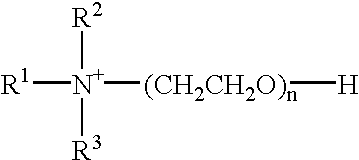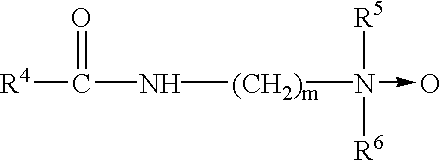Antimicrobial hard surface cleaner comprising an ethoxylated quaternary ammonium surfactant
a technology of quaternary ammonium surfactant and antibacterial technology, which is applied in the direction of detergent compositions, detergent compounding agents, liquid soaps, etc., can solve the problems of not teaching, revealing or suggesting the use of modified quaternary ammonium surfactant to enhance cleaning and filming/streaking performance, and achieves a preferably low amount, improves cleaning performance or aesthetic qualities, and worsens streaking/filming attributes
- Summary
- Abstract
- Description
- Claims
- Application Information
AI Technical Summary
Benefits of technology
Problems solved by technology
Method used
Image
Examples
examples 13-23
In the next set of examples, the filming / streaking performance of the invention was compared versus two nationally available commercial products. Filming / streaking performance is measured by comparing each formula against one another and against the commercially available cleaners for filming / streaking on black ceramic tiles. All of these formulas, including the commercial cleaners, contained a quaternary ammonium compound as a biocide. A grading scale of 1 to 10 was used, with 1 being worst and 10 being best. The results are tabulated in FIG. 1 accompanying the application. Here, the Y axis represents the score on a 1 (although plotted to zero) to 10 scale, the X axis indicates the product used, and the invention is portrayed as 9, etc. from Tables I and II, while the comparison examples are CP#1 (409 APC) and CP#2 (Lysol). When there is no overlap between vertical retangular bars in scores, that indicates generally superior performance of the higher scoring product. As can be seen...
examples 24-30
In the next seven examples, the surface sanitization and disinfectancy performances of yet further inventive formulations was tested. TABLE III shows the formulations:
These formulations were tested for surface sanitization (This means a product which reduces contaminants in the inanimate environment to levels considered safe according to a public health ordinance, or that reduces the bacterial population by significant numbers where public health requirements have not been established; generally demonstrated by 99.99% contact kill for microorganisms). In this test, a surface contains 5% soil and kill is determined within 30 seconds, with a greater than 99.9% kill needed to establish sanitization. The results are set forth in TABLE IV.
These data demonstrate that all but Example 26 have surface sanitization performance.
In the next TABLE V, disinfectancy performance is evaluated. Disinfectancy generally means elimination of many or all pathogenic microorganisms on objects or surfaces w...
PUM
| Property | Measurement | Unit |
|---|---|---|
| vapor pressure | aaaaa | aaaaa |
| cloud point | aaaaa | aaaaa |
| alkalinity | aaaaa | aaaaa |
Abstract
Description
Claims
Application Information
 Login to View More
Login to View More - R&D
- Intellectual Property
- Life Sciences
- Materials
- Tech Scout
- Unparalleled Data Quality
- Higher Quality Content
- 60% Fewer Hallucinations
Browse by: Latest US Patents, China's latest patents, Technical Efficacy Thesaurus, Application Domain, Technology Topic, Popular Technical Reports.
© 2025 PatSnap. All rights reserved.Legal|Privacy policy|Modern Slavery Act Transparency Statement|Sitemap|About US| Contact US: help@patsnap.com



